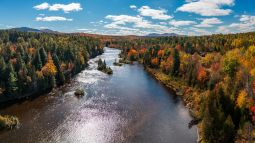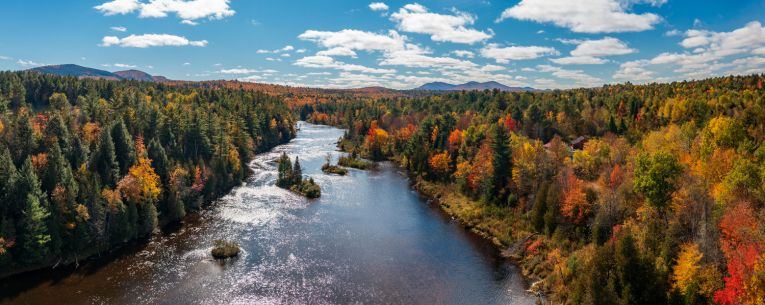If you had to choose one word for how climate change is affecting travel, it would be unpredictable. Natural disasters, more frequent storms, and wild swings in weather all make it harder to plan travel and know what to expect.
Climate change is also causing travelers to become more mindful of how their choices affect the Earth. Travel and tourism account for an estimated 8% of global carbon emissions. “Combatting overtourism is critical as part of an overall more sustainable and responsible tourism ethos and model, and to reaching net zero goals,” the World Economic Forum warns.1
What does this mean for the near future? Here are just a few of the travel trends that reflect the reality of climate change.
1. Travelers are choosing cooler destinations.
Extreme summer heat and wildfires in southern Europe have driven tourists northward. “The biggest loss of tourism revenue is expected in Greece, Spain, Italy and Portugal, while countries expected to see the most tourism growth are Denmark, Finland, Ireland, Sweden and the United Kingdom, among others,” Deutsche Welle reports.2
The “coolcation” trend can be seen in North America, too. Places like the Adirondacks, the Oregon coast, Maine, and Ontario are becoming more alluring. Of course, not everyone is eager to trade their swimsuit for a jacket; beach vacations remain popular.
2. Climate change is increasing shoulder season travel.
Shoulder season—that not-too-cold, not-too-hot time between the high and low seasons—has long been considered a bargain for travelers. That’s changing, however. As people shun the blazing temperatures of summer, many destinations are seeing more visitors in spring and fall, or on the edges of the rainy season.
Want to avoid the growing shoulder-season crowds? Consider nudging your trip just a week or two closer to the off season, which can make a big difference. Read more: The Insider’s Guide to Shoulder Season Travel
3. People may start taking longer vacations closer to home.
Air travel has a significant climate impact, especially long flights. One recent study of tourism in Europe, the U.S. and Canada found that 17% of the most distant arrivals cause 62% of carbon dioxide emissions.3
Experts predict that long flights will get more and more expensive. “As governments grapple with the climate crisis, the cost of long-distance travel is likely to rise, potentially dampening demand,” Skift reports. “Long-haul commercial flights will likely become costlier as some governments impose increased taxes and regulations on jet fuel.”4
The natural result: People will reduce the distance they travel. Destination countries should give tourists an incentive to stay longer, instead of trying to increase the number of arrivals each year, the study authors say.
4. Regenerative travel is becoming more popular.
What is regenerative travel? It means tourism that improves a destination, rather than degrading it. The money a traveler spends and the actions they take on their trip are reinvested into local communities and environmental restoration.
For example, the Boca de Agua ecoresort in Balacar, Mexico, a collection of treehouse-style villas, restores mangrove forests, preserves endangered plants, and welcomes researchers to study its resident population of spider monkeys. Other regenerative travel destinations encourage visitors to plant trees or clean up beaches during their stay.
5. Extreme weather is causing travel infrastructure to break down.
When the temperature rises above 86°F (30°C), train-track rails can misalign, threatening derailment. As a result, passenger trains often slow to a crawl.
When the temperature climbs to 100°F (38°C) or more, the tarmac on runways softens, forcing airports to halt traffic. Ground crews can’t work in extreme heat, and planes have a harder time lifting off.
High heat can cause roads to buckle, especially in areas that aren’t accustomed to searing summer temperatures. Floods devastate road networks, too. In U.S. coastal regions alone, more than 60,000 miles of U.S. roads and bridges are vulnerable to flooding.5
It’s safe to say that travel disruptions will increase as extreme heat and weather events become more common. In situations like these, travel insurance with travel delay benefits is invaluable. Travel delay benefits can reimburse certain expenses during a covered delay, such as hotel stays and meals, as well as reimbursing prepaid costs if you miss part of your trip because of a covered delay.
6. In many places, adventure travel is getting riskier.
California’s Death Valley National Park is one of the world’s hottest places, hitting a record high of 130°F (54°C) in 2021. The extreme heat hasn’t deterred tourists—thousands of people flock there in summer to experience the otherworldly landscape and super-intense heat. But it has real risks. In 2024, one motorcyclist died in Death Valley and another was hospitalized due to heat exposure. Emergency medical helicopters couldn’t reach them, because they can’t fly safely over 120°F (48.8°C).6
Heat, wildfires, flash flooding and other extreme weather all pose dangers to active travelers, even if you’re an experienced outdoorsperson. That’s why it’s essential to have a travel safety plan and always, always carry travel insurance. Look for a plan that includes emergency transportation benefits, which can cover the cost of transporting you to the nearest appropriate medical facility (and back home, too) following a serious covered illness or injury.
7. More than ever, travelers need protection against the unexpected.
As the hip-hop group Outkast sang, “You can plan a pretty picnic, but you can’t predict the weather.” That’s why you need travel insurance. When severe weather cancels your flight, delays your departure, closes the roads, or floods your beach house, travel insurance is there to help make things right.
Download the Allyz® TravelSmart app before you travel, so you can easily contact local emergency services, reach 24-hour assistance, or file a claim. And if you’re traveling soon, the time to buy insurance is now. Get a quote.
Related Articles









Share this Page